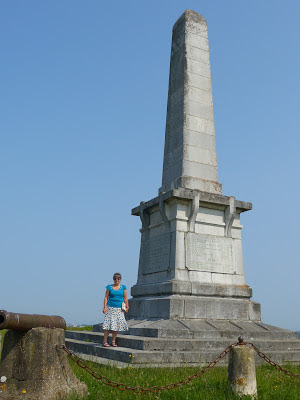Today we
left for Bayonne. On the way, driving down the valley of the Nive, which by the
way, was a very beautiful drive, we went through a number of villages mentioned
in dispatches as sites of fierce engagements. The land is so broken up and the
rivers are so fierce (remember that the fighting in this area was in winter),
that there wasn’t a “battle”, with both armies drawn up opposing each other.
We stopped
at the Croix de Mouguerre, erected in memory of Soult’s defence of France and
the soldiers who died. It’s to honour Soult “who with inferior forces, foot by
foot, defended this country for seven months against the army of Wellington.”
 |
| The Soult memorial |
In fact the
numbers were pretty equal overall. Wellington had to send home his Spanish
troops. The Spanish were too inefficient to supply their men, who sometimes actually
starved; this meant that they were driven to looting, the one thing Wellington
was extremely anxious to avoid. He did not want the population driven to
guerrilla action as the Spanish had been. In fact, the French civilians, far from
finishing off British stragglers or the wounded, took care of them, knowing
they would be compensated for their trouble. But Soult certainly made life difficult for Wellington's army.
There’s a
nice story about Wellington talking to the rather garrulous mayor of an
occupied French town, and inviting him to dinner. The mayor couldn’t believe
Wellington’s courtesy, and contrasted it with the behaviour of the French
generals, who had treated him “like a dog.”
Anyway the
Croix de Mouguerre marks the site of an extremely sharp engagement , St Pierre,
when the French tried to drive off the British army investing Bayonne. The British army was widely spread, and one
of the two pontoon bridges which had been put across the Nive was swept away,
making troop movements very slow. The British around St Pierre were commanded
by General Hill, and were outnumbered three to one, so there were some very
ticklish hours before Wellington was able to bring up the 6th
division. Wellington did not take over,
however, commenting “My dear Hill, the day’s your own.”
 |
| The hills on which the action of St Pierre was fought. |
There were
a number of incidents which bear telling – the colonel of the Gloucesters,
announcing “Dead or alive, we must hold our ground”; General Stewart, who had
lost his entire staff, remarking “A shell, sir. Very animating”, as one fell at
his feet; the ADC sent to order a brigade to attack, who ended up leading the
attack himself, because all the senior officers were dead.
But there
was also a shaming incident. The new commanding officer of the 71st
Highlanders, Colonel Peacock, lost his nerve and ordered them to abandon their
positions. Hill himself found them, and Stewart personally formed the Highlanders up and led them into the battle. Peacock’s behaviour caused Hill to swear for
what is believed to be only the second time in the whole war! (As far as I can
make out, Picton never stopped swearing.)
Bayonne is
a really pretty town, with loads of attractive houses. Building outside the
fortification was forbidden until the beginning of the twentieth century, so it’s
very well preserved. It’s on the confluence of the Nive and the Adour, which is
a really big river, and the old walls and some of the towers are turned into old
houses. The gateways are still there. But outside the old walls are the modern
fortifications (Vauban again).
Wellington didn’t
attempt to take it by storm – much too costly – but kept it blockaded, like
Pamplona.
Unfortunately,
the governor of Bayonne, General Thouvenot, decided, after he had heard about
Napoleon’s abdication, to launch a sortie. The British seemed to have relaxed,
believing the war to be over. After being driven back, and in some considerable
confusion, they were saved by the Coldstream Guards under Colonel Maitland
(later to behave heroically at Waterloo) and the King’s German Legion.
Thouvenot withdrew his men. The British losses were over 800, and the French over
900, and all for some laughable idea of “honour”. The British officers, who had been slogging
their way right from Lisbon, for five years, were seriously shocked by the
waste.
 |
| The 1st Foot Guards (Coldstream) cemetery |
There are a
couple of cemeteries for the British Guardsmen, and we visited one. Most of the
memorials are for officers, but there was one for a company sergeant, who had
served in the Coldstream Guards for twenty years. It’s like being killed on November 12th
1918.
No comments:
Post a Comment